How to Use Water Wisely in Your Garden and Landscape
- horticulturist and gardening expertJuly 22, 2023
There never seems to be the right amount of water for our gardens. There is either too much or not enough water and never when your garden needs it. Add to this extended droughts, flooding, and watering bans. What is a gardener to do? Make a few changes in your plant selection and garden care so you can manage water use while growing healthy gardens.
Using water wisely is not just about growing drought-tolerant plants or eliminating plantings. It is a holistic approach to managing water. The goal is to avoid flooding that overwhelms sewer systems, improper watering that wastes water, and poor landscape designs that generate too much work and require too many resources, including water, to maintain.
Incorporating wise watering habits into your gardening is good for your garden, the environment, and your pocketbook. Start with one or more of these strategies this year and incorporate more each season.
Select the right plant for the growing conditions to reduce water usage
Plants that thrive in normal growing conditions for your area will be healthier, require less care, and need less water once established. These conditions include sunlight, wind, and soil in your yard and the average amount of rainfall in your area.
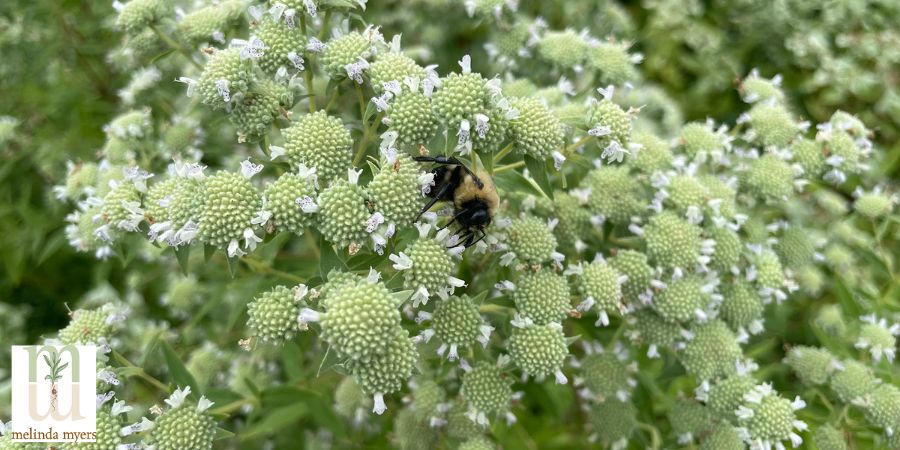
Bee on Pycnanthemum virginianum
You will find a variety of terms used to describe plants and their need for water. They are often interchanged so the University of Utah provided helpful definitions of these terms. This should help you as you research and select plants for your gardens.
Water-wise plants are those that evolved in areas with less precipitation and generally require less water than most plants used in residential landscapes. Drought-tolerant plants, once established, can survive dry periods but do require a return of regular moisture to maintain their growth and appearance. Those identified as xeric do not need supplemental water once established. You’re local extension service and nature centers can help provide a list of plants suited to the growing conditions in your location.
All plants need sufficient moisture after planting and for several months to a year or two to develop a robust root system and become more drought tolerant. Always water the area surrounding new plantings thoroughly when the top few inches of soil are crumbly and moist. Gradually reduce the frequency, and once the plants are established, you will need to water less often.
Plants that use a lot of water
Some plants like ligularia, cardinal flower, turtlehead, Joe pye weed and ironweed thrive in moist soil conditions. Many are used in rain gardens and areas that stay moist or wet for long periods. They do not thrive in consistently dry conditions.
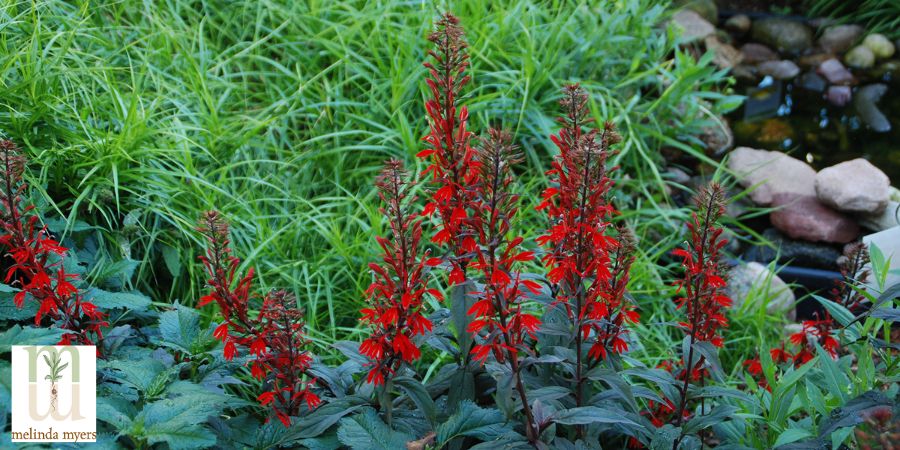
Lobelia Cardinalis
Avoid these and other moisture lovers when gardening in areas with limited rainfall. Selecting plants suited to your growing conditions saves time and avoids the frustration that follows when trying to keep those plants not suited to the environment alive and looking their best.
Plants to avoid in your landscape
Do not plant and remove any invasive plants growing in your landscape. These non-native plants fill our landscapes and leave their boundaries invading nearby natural areas. They tend to start growing earlier and keep growing later in the season, giving them an advantage over our native plants. These plants reproduce easily and rapidly taking over a disturbed area, crowding out native plants and disrupting the natural balance needed to support our pollinators and wildlife. Their presence also impacts water quality by increasing runoff and soil instability.
I realize eliminating them from the landscape is not an easy task. I am working on some of my own. Contact your extension service, nearby nature center or Department of Natural Resources for useful information on invasive plants to avoid and how to eliminate those in your landscape.
Help prevent the spread and future infestations of these problem plants. Don’t share aggressive and invasive plants with others. Remove and destroy any aggressive, invasive, and restricted plants from your landscape and dispose of them properly. Check with your local municipality for guidelines.
Keep water in the garden and out of the storm sewers
Reduce the risk of flooding while improving your garden. Adding several inches of compost to the top 8 to 12 inches of soil increases the soil’s ability to absorb and retain water. This means less runoff into the storm sewers and less frequent watering.
Topdress existing gardens by spreading an inch of compost over the soil surface. Soil organisms will help move it into the soil to improve plant growth. Lend nature a hand by using an auger bit on a drill to aerate compacted soil and push some of the compost into the top 4 to 6”.
Mulching the soil with leaves, evergreen needles, or other organic matter also helps. This one task has many benefits, including; conserving moisture, reducing the risk of erosion and compaction, suppressing weeds, and as the mulch decomposes, it improves the soil. A one-to-three-inch layer over the soil surface is all you need. The finer the mulch material, the thinner the layer of mulch needed.
Use plants to prevent runoff and conserve water
Plant trees, shrubs, and groundcovers to slow the flow of rainwater, increase the amount of water that stays in your landscape for your plants to use, and help filter rainwater before it enters the groundwater.
Include native plants whenever appropriate. They help manage rainwater in our landscapes by slowing water running off the roof, hard surfaces, and the lawn helping to keep it out of our storm sewers and waterways.
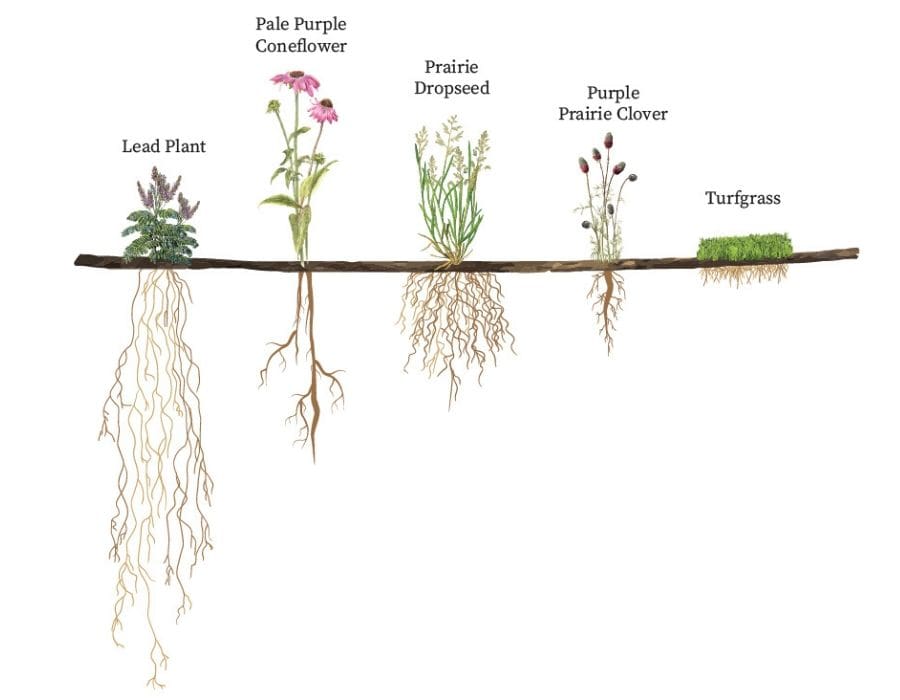
Their deep roots also improve the soil. The roots help break apart heavy compacted soils and as old roots die, they add organic matter. All this supports healthy plant growth. These deep roots also create pathways for water to infiltrate and travel through the soil to the groundwater. The plant roots and soil help remove dust and pollutants from the water before it reaches the groundwater.
You’ll enjoy additional benefits when growing native plants. They attract and support songbirds, pollinators, and other beneficial insects since they all evolved together over time. Beneficial insects help manage garden pests, and many pollinate much of our food, fiber, medicines, and other products we depend upon. Make sure the native plant you select is suited to the growing conditions and will fit in the available space once mature.
Install one or more rain gardens if your area is subject to periods of wet and dry weather. These gardens are designed to capture runoff from lawns and hard surfaces and remove dirt and pollutants from the water before it enters the groundwater. When done properly, it is a beautiful way to manage water, reduce the risk of flooding, and improve water quality.
Provide plants with a healthy diet and use a slow-release non-leaching organic nitrogen fertilizer like Milorganite®
You’ll encourage slow, steady growth so your plants will require less water and will be less prone to insect and disease problems. The slow-release nitrogen encourages healthy growth, does not prevent flowering and fruiting, and won’t damage plants when weather turns hot and dry. Milorganite also contains 85% organic matter, so it helps build healthy water-absorbing soil while feeding your plants.
Water your plants wisely
Water plants thoroughly and only when needed. Water the soil, not the plant using a watering wand, drip irrigation, or a soaker hose so less water is lost to evaporation. Water early in the morning whenever possible to reduce water loss during the heat of the day and diseases caused by wet foliage at night.
Water new plantings often enough to keep the roots moist but not soggy wet. Gradually reduce the frequency to encourage deeper, more robust roots. It takes months even a year or two to establish perennials, trees, and shrubs. Once established, continue to water thoroughly when needed.
Manage your lawns to reduce water use
Many gardeners are looking for alternatives to the traditional lawn. Some are planting more low-growing drought-tolerant plants that support pollinators. Others are reducing the amount of lawn in their landscape and increasing garden beds filled with trees, shrubs, and groundcovers that require fewer resources, including water, to maintain.
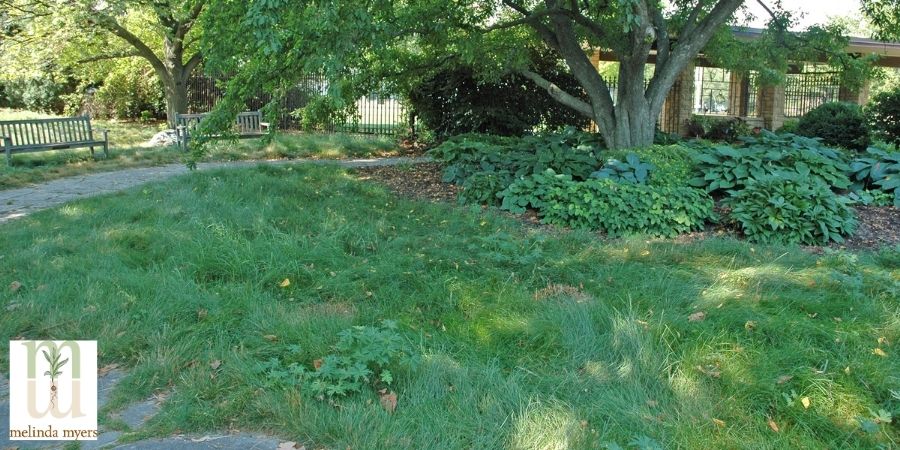
Meadow lawn
If you prefer a bit of lawn, reduce watering needs by growing more drought-tolerant grass varieties recommended for your area. Prepare the soil before seeding or sodding or aerate and spread a thin layer of compost over existing lawns to increase water absorption and reduce runoff. Mow high to encourage deep roots that are more drought-tolerant and pest resistant. Allow lawns to go dormant during hot, dry weather. Provide them with ½” of water every 3 weeks during extended dry periods. This will keep the plant dormant but the crown of the plant alive so it can recover when rain returns.
If you do irrigate, water thoroughly when needed, that’s when your footprints remain on the lawn. Water early in the morning to reduce evaporation as temperatures rise.
Conserve water and reduce time and money spent on plant care
Mulch soil around trees, shrubs, and other plants with several inches of wood chips, shredded leaves, evergreen needles, or other organic material. Mulching reduces watering frequency, prevents soil compaction from heavy rainfall, increases water absorption, and adds organic matter to the soil as it decomposes.
Always pull mulch away from the trunk of trees, stems of shrubs, and crowns (where roots meet the roots) of perennials. Burying these above-ground parts of the plants can lead to rot, disease, and other problems.
Repair leaking faucets, fittings, and garden hoses
A slow leak of one drip per second can waste up to 9 gallons of water per day. Repairing leaks eliminates the annoying drip and saves water. This one fix can make a big difference in your water use.
Look for and use wasted water in your garden
Collect the “warming water” typically wasted when preparing baths and showers. Use a 5-gallon bucket to collect this fresh water and use it for your containers and gardens.
Collect water from your dehumidifier and window air conditioners for use on flowering plants. Do not use this water on plants if environmentally harmful solvents have been used to clean the equipment.
Check with your local municipality if you are considering using gray water
Once you wash clothes, dishes, or yourself water is classed as gray water. Some municipalities are allowing this untreated water, NOT including toilet water, to be used for watering lawns and gardens.
Harvest rainwater in rain barrels if your municipality allows
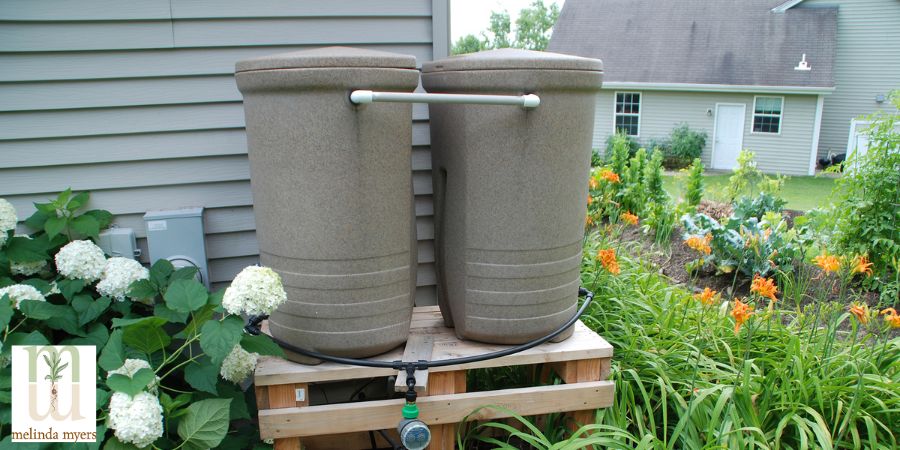
The ancient technique of capturing rainwater in jugs, barrels, and cisterns has made a comeback. Collecting rain when it is plentiful and storing it until it is needed is one way to manage water to use on your landscape. But first, check local regulations before installing a rain harvesting system. Several states have banned rain harvesting, while others offer rebates or rain barrels at a discount to gardeners.
I am often asked if it is safe to use this water on edible plantings. Rutgers University did extensive testing on harvested water and found the overall water quality was good but it does vary. They recommend using water collected in rain barrels only for ornamental plantings and containers unless you test the water and find it is safe for use on edible plants.
Start your water-wise conversion by incorporating one or more of these water-saving strategies into your gardening practices. As you master the first few add more. Soon you will find it is easy to be water-wise when growing and caring for your gardens and landscape.

